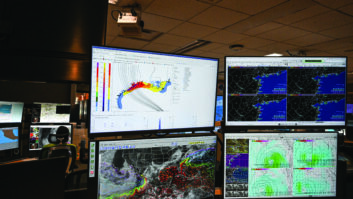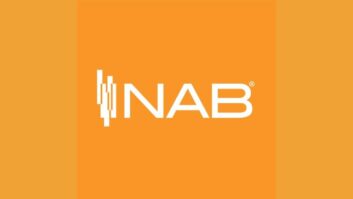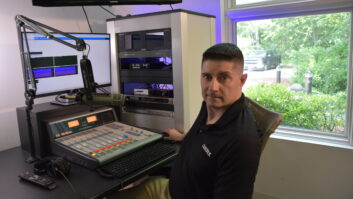
Members of the HCJB staff pose with a crated, refurbished Continental 10 kW AM transmitter before it was shipped to Indonesia this summer.ELKHART, Ind.
Thousands of radio listeners around the world can tune in their favorite Christian radio stations thanks, in part, to the work done at a broadcast technology center in this northern Indiana city.
The HCJB Global Technology Center, founded to design and build specialized high-power shortwave transmitters, has evolved into a hybrid tech center that also offers a variety of broadcast services to Christian organizations worldwide, including consulting and broadcaster training.
Tech center staff design and manufacture FM antennas, sell their own automation system called Wings and pre-package studios for use by evangelical broadcasters.
The industrial complex here is part of HCJB Global, a non-profit Christian organization headquartered in Colorado Springs, Colo.
HCJB Global transmits Christian programming via shortwave radio from broadcast facilities in Ecuador and Australia. It also has helped partner ministries start more than 300 radio stations in more than 100 countries. HCJB is an acronym for “Heralding Christ Jesus’ Blessings.”

Staff members Herb Jacobson, Charles Jacobson and Peter DeBonte, from left, carry out DRM bench tests with the HCJB low power shortwave transmitter.
It was the need to design and build a 500,000 watt shortwave transmitter capable of overcoming Russian jamming that led HCJB Global broadcast designers and engineers to take up residence at Crown International in Elkhart at the invitation of Clarence Moore, founder of Crown International.
Moore had at one time served as chief engineer at HCJB Radio in Quito, Ecuador, and invited the Christian broadcaster to work on the shortwave project at Crown’s facilities in the mid-1970s.
Crown
That relationship continued until 2000 when Harman Pro Group North America purchased Crown International and its line of power amplifiers. The property and buildings that house the HCJB Global Technology Center were given to HCJB Global by the Moore family at that time.

HCJB Global Technology Center staffer Ken Cummings packs an FM transmitter for shipment. Since then, tech center staffers have been involved in research, development, training and technical support for AM, FM and shortwave radio stations as well as satellite distribution and satellite-based Internet services, said Charlie Jacobson, manager of international broadcast technology for HCJB Global.
The facility’s name changed in 2007 from the HCJB World Radio Engineering Center to the HCJB Global Technology Center to reflect a more global outreach, Jacobson said.
“Our focus is not just on development and engineering, but also service and training in technology for Christian ministry,” Jacobson said.
Two industrial buildings on the site, measuring together approximately 23,000 square feet, house a machine shop for work on FM antennas and other mechanical assemblies, a transmitter assembly and fabrication area, an electronics research lab and training facilities.
Approximately 40 people work at the tech center, Jacobson said. Some are volunteers; about 28 are paid staff with missionary status, which means, “They have raised the funds in order for them to be here,” Jacobson said.

Technology Center staffers conduct proof-of-performance tests on fix-tuned solar-powered FM receivers manufactured in China.
The majority of the facility’s funding for personnel and projects comes from donations, Jacobson said. Other sources of income include the sale of transmitters and antennas. Jacobson declined to give specific operating budget information for the HCJB tech center.
DRM
HCJB Global considers itself a pioneer in its work on Digital Radio Mondiale, the digital broadcasting system for broadcasting bands below 30 MHz, which includes international AM broadcast and shortwave bands.
Herb Jacobson, HCJB senior design engineer and Charlie’s father, served on the Channel Coding & Modulation Technical Subcommittee of the DRM consortium and wrote the first white paper detailing transmitter design changes required for compliant DRM transmission, Charlie Jacobson said.
“We have been very committed to digital broadcast technology and committed to DRM since 2000. We have a DRM product that is both a content server and AM modulator and we are extending that to our shortwave transmitters. We see DRM as a means to open up the market for shortwave across the world. However, a lot of it is ‘wait and see,’ mainly from the receiver development end.
“We want to be very active at developing future technologies in broadcasting.”
At one point, HCJB Global Technology supplied Harris with a DRM content server and exciter compatible with the Harris line of solid-state AM transmitters. That relationship has since ended, Jacobson said.
HCJB Goes GlobalHCJB Global, known as HCJB World Radio until 2007, is a multifaceted Christian organization that includes a medical ministry and television operations.
HCJB Radio aired its first shortwave radio broadcast from Quito, Ecuador in 1931. Originally featuring English and Spanish language programming, the shortwave station later added German, French, Russian, Portuguese, Japanese and Dutch.
HCJB Global broadcasts the gospel in five languages from its Quito facility, which feature 10 radio studios and a master control. Its international transmitter site is located just outside of Quito and includes one 500 kW, four 100 kW, two 50 kW, two 25 kW and two 10 kW shortwave transmitters.
The Christian broadcaster also has launched a podcasting initiative featuring satellite-based Internet services in an effort to reach a new, younger generation of listeners. “We are the only U.S.-based group to have developed a DRM transmitter exciter package. The content server is a PC Linux-based DRM encoder and multiplexer, using Coding Technologies’ AAC audio encoder, but all other software was developed by HCJB,” Jacobson said. “The exciter is a DSP-based single-board DRM channel encoder and RF generator with hardware and software developed by HCJB.”
‘Radio planting’
Shortwave transmitters are built at the tech center on an “as needed” basis, Jacobson said. Demand for high-power transmitters — up to 500,000 watts — has dropped dramatically as Christian broadcasters have discovered satellite and Internet distribution channels.
“We just completed a 100,000 watt high-power shortwave transmitter for Transworld Radio in Swaziland, Africa. Over the years we have built nine of the 100,000 watt models, but we do not have any plans to build any more of them. We continue to build a 1,000-watt shortwave transmitter,” Jacobson said.
The tech center’s consultation work includes evaluating a Christian broadcaster’s equipment needs as well as providing coverage studies, Jacobson said. It’s through HCJB Global’s “radio planting ministry” that many religious broadcasters have gotten their start.
The popularity of lower-power FM stations in foreign countries, especially across Southeast Asia and parts of Africa, has benefited the tech center. Tech staffers have worked on a number of startups, which typically include Crown Broadcast 250-watt transmitters, which can literally fit inside a suitcase, and HCJB Global Technology FM antennas and automation systems.
Those broadcasting partners often are inexperienced, which has led to an increased need for technical training for both in-house staff and people working at the radio stations, Jacobson said.
“We are in the process of developing a more thorough training system, everything from installs to upkeep of facilities to automation system training and studio maintenance. Training typically lasts up to a month,” he said.
In some cases, Jacobson said, missionary engineers will be sent to train on site. At other times, partner broadcasters send trainees to Elkhart for a series of training sessions.
“We are currently expanding a media training center, which will include a studio with full broadcast capability,” Jacobson said.
In addition to its design work with transmitters and antennas, the HCJB Global Technology Center has developed a fixed-tuned solar-powered FM radio that can be pre-tuned to pick up specific Christian radio stations.
“We sell them in bulk to our radio partners to distribute them to them to their listeners. They are intended for use in rural areas where there is limited reception. We are hoping to add AM and shortwave to the unit,” Jacobson said.







